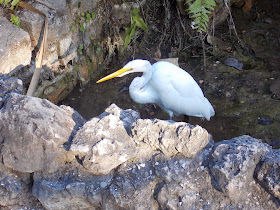Part of our admission ticket to the zoo paid for a guided catamaran tour around islands of apes, monkeys and lemurs.
It was near the evening feeding time for the animals so our tour guide warned us not to have any food in our hands as the animals, seeing food, may jump aboard thinking it was their food. He did note, however, that so far no monkeys have jumped off the islands, even though they can swim. Pictured below are the spider monkeys, they do look like spiders when swinging in the air! On the islands are covered huts with heat lamps for the monkeys. We learned that a hard freeze does occur here about once every ten years.
What we like about the zoo were the presence of many of the local wading birds and ducks which can unexpectedly be found walking the grounds, roosting in the trees or feeding in the lake.
That about wraps it up for the zoo, I only mentioned but a few of the many animals which can be seen there.
We also had an interesting meeting with several Florida University college students who were doing surveys of the visitors at the zoo. They wanted to know what conservation means to us. It was an easy question for us to answer, as we have seen the impact of development on wildlife while visiting the preserves and swamps of Florida. Without a doubt, holding onto land for nature to thrive is important.
Our day was done and we had to hurry from the zoo if we wanted to walk around Tin City before dark. In the 1920s this harbor of the Gordon River was the hub of Naples' fishing industry. The colorful tin-topped buildings were home to clam shelling, oyster processing, boat construction and maintenance. In the 1970s seven of those buildings became home to "The Old Marine Marketplace at Tin City". We had a wonderful seafood supper at one of the waterfront restaurants, and took some time to check out a few of the boutiques. Somehow we still had the energy to walk over a nearby bridge to view the sunset.





No comments:
Post a Comment